Cancer stem cells play a big role in how well cancer treatments work. These cells can grow and change, causing new tumors to form. They are key in making cancer progress and resist treatment. In the U.S., about 1,665,540 new cancer cases were expected in 2014, leading to around 585,720 deaths.
The death rate from cancer has dropped by about 20% in the last 20 years. But, finding effective treatments for cancer is a big challenge.
Studies show that cancer stem cells are a part of tumors that can make them come back and grow. These cells have been found in many types of solid tumors, like breast, brain, lung, colon, and melanoma cancers. Knowing how cancer stem cells affect treatment is key to finding better therapies.
The field of oncology has made big steps in finding and understanding cancer stem cells. There is wide agreement on what these cells are and how they work in cancer.
Cancer treatment outcomes are greatly influenced by cancer stem cells. Their ability to grow and change makes them a big problem in fighting cancer. It’s very important to think about how cancer stem cells affect tumor growth and coming back.
The relationship between cancer stem cells and tumor growth is complex. Understanding this is vital for creating effective cancer treatments.
Key Takeaways
- Cancer stem cells are a critical factor in cancer treatment outcomes.
- These cells have the ability to self-renew and differentiate, leading to the formation of new tumors.
- Cancer stem cells have been identified in multiple solid tumors, including breast cancer, brain tumors, lung cancer, colon cancer, and melanoma.
- Understanding the impact of cancer stem cells on cancer treatment is essential for developing effective therapies.
- The field of oncology has made significant strides in the identification of cancer stem cells.
- Cancer stem cells are a significant challenge in the treatment of cancer due to their ability to self-renew and differentiate.
What Are Cancer Stem Cells and Their Role in Disease
Cancer stem cells are a special group of cancer cells. They can make more of themselves and turn into different cell types. This helps start and grow tumors.
Research in stem cell research shows these cells are key in tumor growth and keeping it going. Scientists have found markers like CD44, CD24, and CD133 to find and study these cells. Understanding how they change into different cells is important for knowing how tumors spread.
The part cancer stem cells play in disease is complex. But, it’s clear they are important in starting and growing tumors. Targeting these cells might help treat cancer. More stem cell research is needed to understand their role and find better treatments.
The Relationship Between Cancer Stem Cells and Tumor Growth
Cancer stem cells are key in cancer progression. They can make more of themselves and turn into new cancer cells. The tumor microenvironment helps these cells grow and live, making it vital for tumor growth.
Studies show cancer stem cells are present at all cancer stages. They cause resistance, recurrence, and spread. The tumor microenvironment creates a space for these cells to grow.
Important factors in this relationship include:
- Self-renewal and differentiation of cancer stem cells
- Support from the tumor microenvironment
- Interaction between cancer stem cells and other cells in the tumor
Knowing how cancer stem cells and tumor growth are linked is key to fighting cancer. By focusing on cancer stem cells and the tumor microenvironment, researchers aim to better treatments. They want to lower the chance of cancer coming back or spreading.
| Factor | Description |
|---|---|
| Cancer Stem Cells | Self-renewing cells that differentiate into new cancer cells |
| Tumor Microenvironment | Supports the growth and survival of cancer stem cells |
How Cancer Stem Cells Influence Treatment Resistance
Cancer stem cells (CSCs) are key players in treatment resistance, a big problem in cancer treatment. Studies have found that CSCs can find ways to avoid the effects of targeted therapy and chemotherapy. This makes treatment resistance a major issue, reducing how well cancer treatment works.
Several factors contribute to treatment resistance:
- Activation of survival pathways
- Adaptive responses to therapy
- Cellular plasticity
It’s important to understand how treatment resistance works to find better ways to treat cancer. By focusing on CSCs and their survival pathways, we might be able to beat treatment resistance and help patients more.
| Cancer Type | Common Cell Surface Markers |
|---|---|
| Lung cancer | CD133+, CD44+, ABCG2 |
| Colon cancer | CD133+, CD44+, CD24+ |
| Breast cancer | CD133+, CD44+, ALDH-1 |
Understanding the Tumor Microenvironment’s Role
The tumor microenvironment is key in helping cancer stem cells grow and survive. It’s a complex mix of cells, like immune cells and fibroblasts, that work together with cancer stem cells. This environment changes how cancer grows and spreads, thanks to factors like low oxygen and high acidity.
Conditions in the tumor microenvironment can make cancer cells act more like stem cells. Cancer-associated fibroblasts, for example, help tumors grow and resist drugs. Using nanocarriers to target cancer stem cells can improve drug delivery by up to 30% compared to old methods.
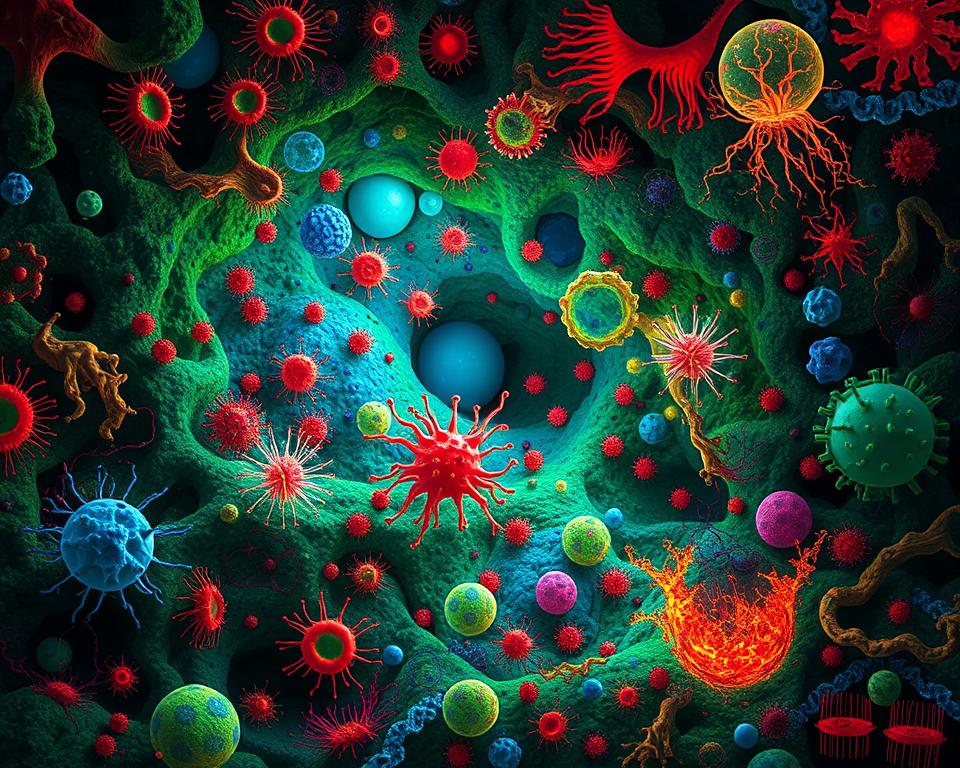
Important factors that help the tumor microenvironment support cancer stem cells include:
- Changes in the environment like low oxygen and high acidity
- How cancer stem cells interact with other cells, like immune cells and fibroblasts
- Environmental conditions that make cancer cells act like stem cells
Understanding the tumor microenvironment’s role is vital. It could lead to new treatments and better outcomes for cancer patients.
Current Therapeutic Approaches Targeting Cancer Stem Cells
Cancer stem cells (CSCs) play a big role in cancer coming back and spreading. Targeted therapy is a new way to fight cancer. It aims to kill CSCs and stop cancer from coming back. Immunotherapy is also being tested as a treatment, with some CSC-targeting agents already approved or in trials.
Some ways to target CSCs include:
- Molecular targeting strategies, which involve targeting specific molecules involved in CSC self-renewal and maintenance
- Immunotherapy approaches, which aim to stimulate the immune system to recognize and attack CSCs
- Combination treatment methods, which combine traditional cancer treatments with CSC-targeting agents to enhance treatment efficacy
These methods might help make cancer treatments better. For example, immunotherapy works well against CSCs in some cancers like leukemia and breast cancer. Targeted therapy targets specific pathways in CSCs.
Overall, these new ways to target CSCs are promising. They could lead to better cancer treatments and fewer relapses. More research is needed to make these treatments even better.
| Treatment Approach | Description |
|---|---|
| Molecular Targeting Strategies | Targeting specific molecules involved in CSC self-renewal and maintenance |
| Immunotherapy Approaches | Stimulating the immune system to recognize and attack CSCs |
| Combination Treatment Methods | Combining traditional cancer treatments with CSC-targeting agents |
Identifying and Monitoring Cancer Stem Cell Activity
Finding and tracking cancer stem cell activity is key to making treatments work better. These cells are behind treatment failure, cancer coming back, and spreading. Scientists are working hard to find ways to spot and keep an eye on them.
Methods like flow cytometry help find cancer stem cells in individual cells. Imaging techniques let us see and follow these cells as they move. This helps us understand how they help tumors grow and spread.
Important biomarkers for finding cancer stem cells include CD44, CD133, and ALDH1. These markers are often found in high amounts in these cells. Imaging techniques like MRI and PET scans can show where these markers are in tumors.
Using these biomarkers and imaging methods, scientists can watch cancer stem cells closely. This helps them create better treatments. For instance, by focusing on specific markers, treatments can target and kill cancer stem cells. This can lower the chance of cancer coming back or spreading.
Challenges in Cancer Stem Cell Research
Cancer stem cells are a big problem in research challenges because they help cancer grow and resist treatment. They are hard to find and study because they make up less than 1% of cancer cells.
Some big challenges in studying cancer stem cells include:
- Understanding how they work
- Finding ways to stop them from causing cancer to come back
- Dealing with their genetic differences
Even with these hurdles, scientists are getting closer to understanding cancer stem cells. For instance, certain signals like Wnt and Notch help keep these cells in a stem-like state. This stops them from becoming normal cells.
Studies have found that cancer stem cells make tumors more varied. This affects how tumors grow and react to treatment. So, it’s key to keep studying them to find better ways to treat cancer.
| Challenge | Description |
|---|---|
| Identification and isolation | It’s hard to find and separate cancer stem cells because they’re rare |
| Genetic diversity | Because cancer stem cells are genetically different, it’s tough to create targeted treatments |
| Treatment resistance | Cancer stem cells make tumors hard to treat, so we need to find effective ways to fight them |
Emerging Technologies and Treatment Innovation
Emerging technologies are changing cancer treatment, making new therapies that focus on cancer stem cells. This is key in fighting cancer, as it leads to treatments made just for each patient. Personalized medicine uses genetic info to make treatments that work better and have fewer side effects.
New technologies in cancer treatment include new drugs, advanced ways to deliver therapy, and personalized medicine. These have shown great promise in trials, with some patients seeing big improvements. For instance, exosome-based therapeutics can help or hinder tumor growth, depending on the type.
As we learn more about cancer stem cells, we can make treatments that really work. The future of cancer treatment looks bright, thanks to new tech and innovative treatments. This will help patients get better care.
| Technology | Description |
|---|---|
| Exosome-based therapeutics | Use of exosomes to deliver targeted therapies to cancer cells |
| Novel drug development | Creation of new drugs that target cancer stem cells |
| Advanced therapeutic platforms | Development of new platforms for delivering cancer therapies |
The Future of Cancer Treatment: Beyond Traditional Therapies
The future of cancer treatment looks bright, thanks to new technologies and ideas. Targeted therapies and immunotherapies are changing how we fight cancer. They focus on cancer stem cells, which are hard to beat with old treatments.
New drugs and combinations are being developed to target cancer stem cells. Better biomarkers and imaging help find and track these cells. This means treatments can be more tailored to each patient.
Personalized medicine is also making big strides. For example, cancer vaccines made from a patient’s genetic information are showing promise. Antibody-drug conjugates and cell-based therapies are also being explored.
The field of oncology is moving fast, aiming to improve cancer care. These advances offer hope for better treatment options. The goal is to make cancer treatment more effective and personal for everyone.



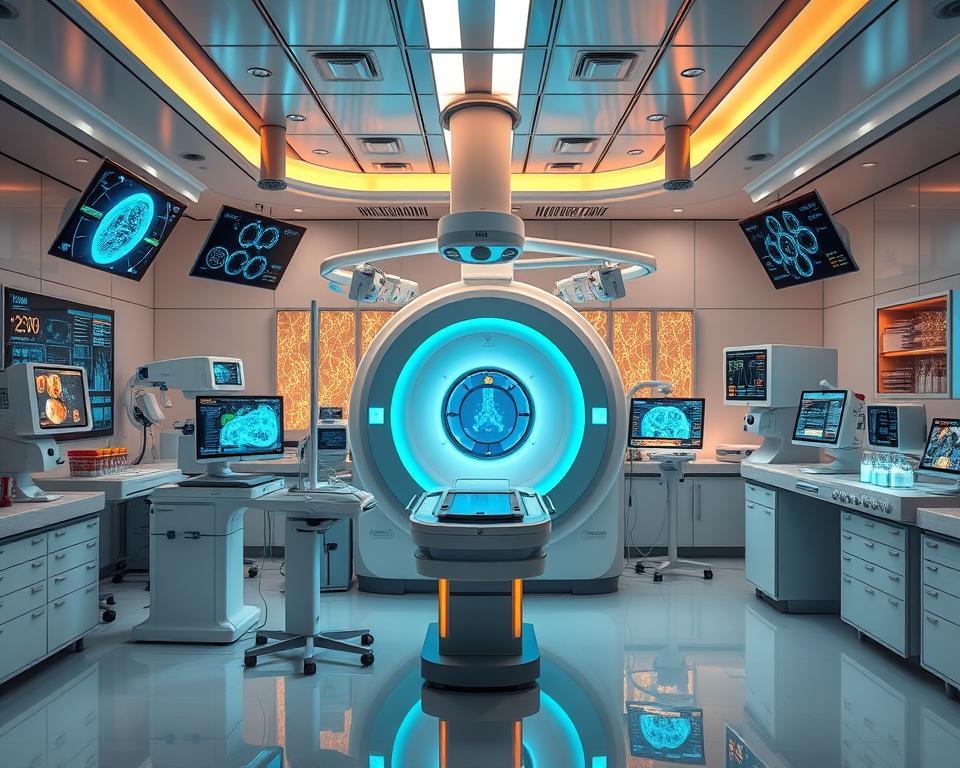
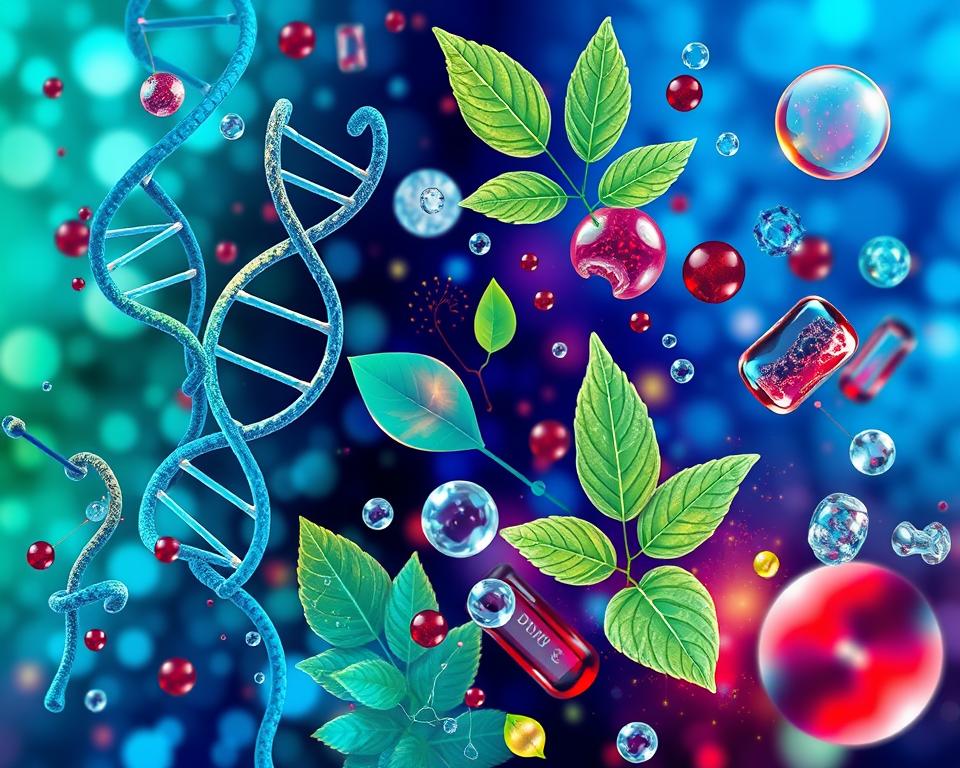
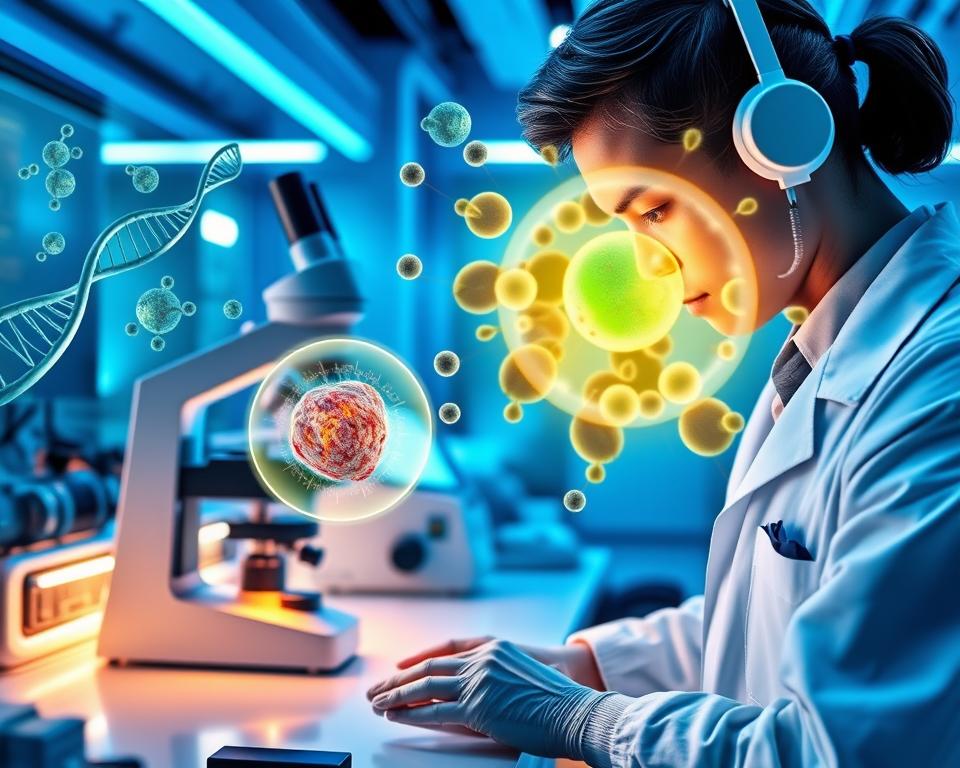
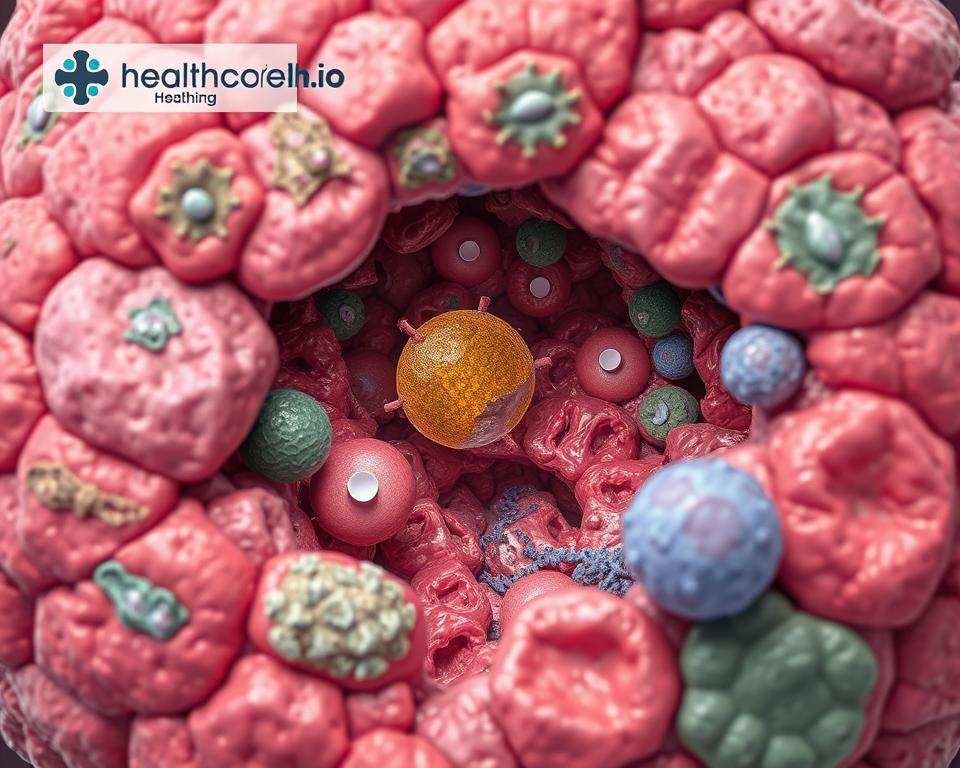






Leave a Reply